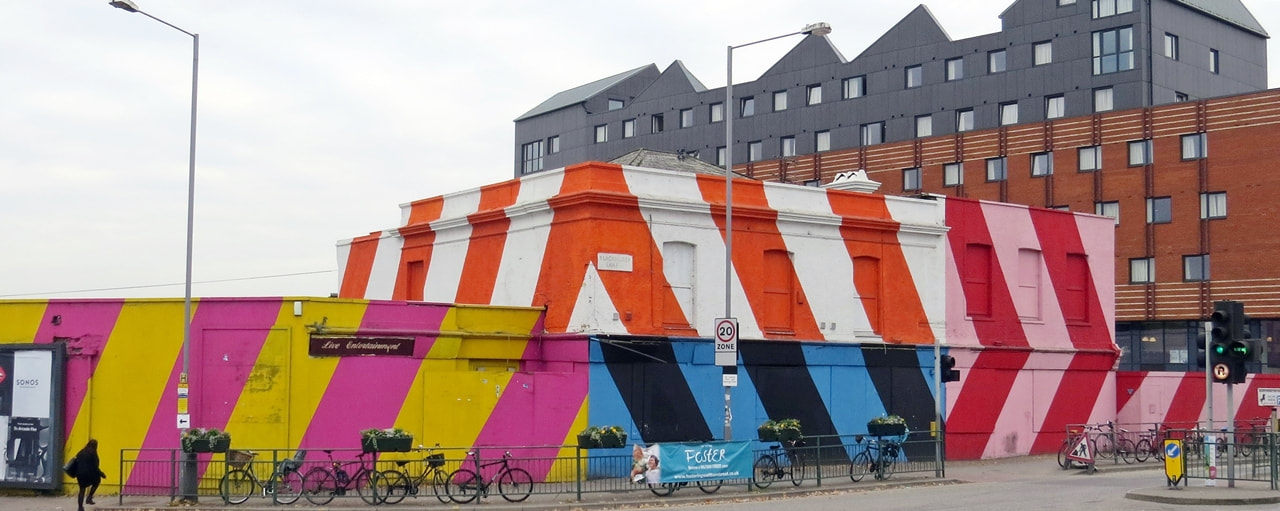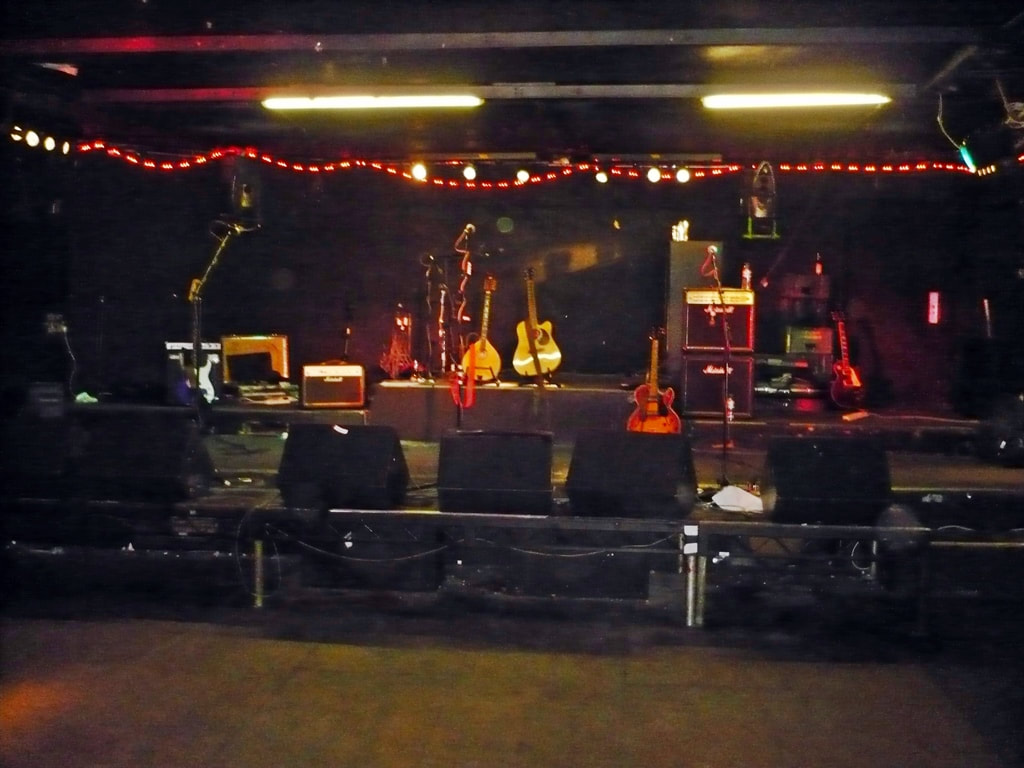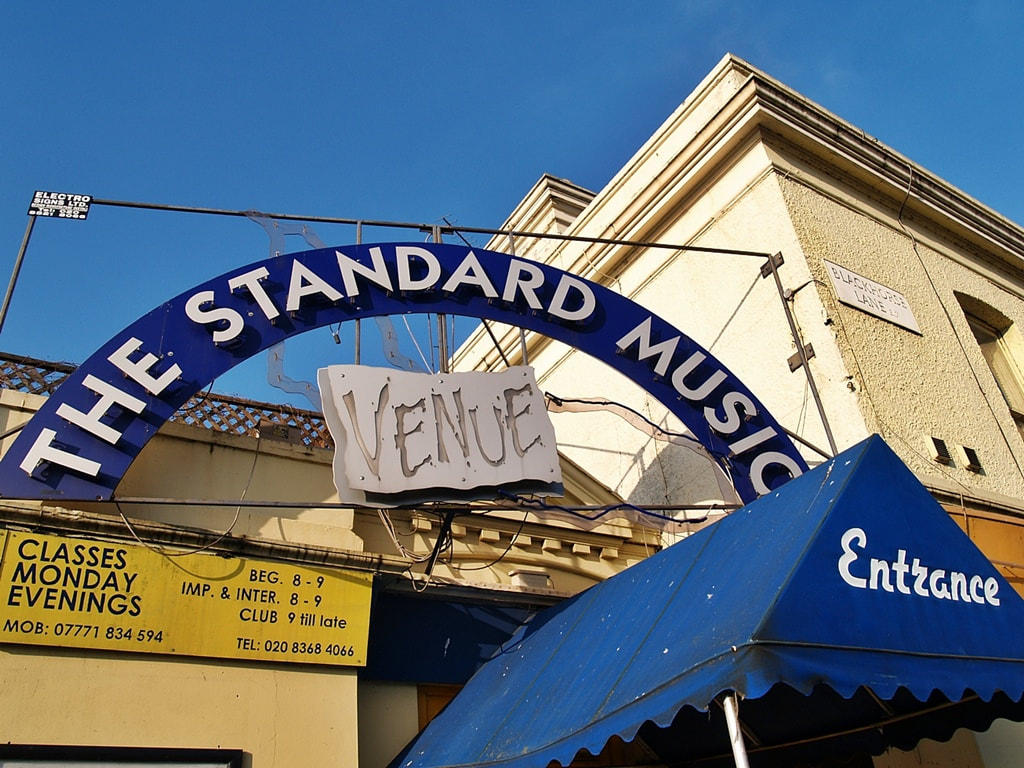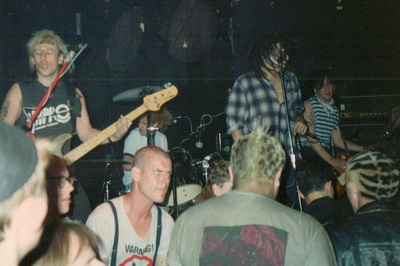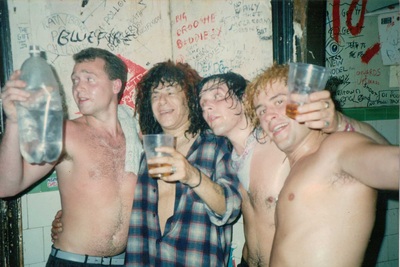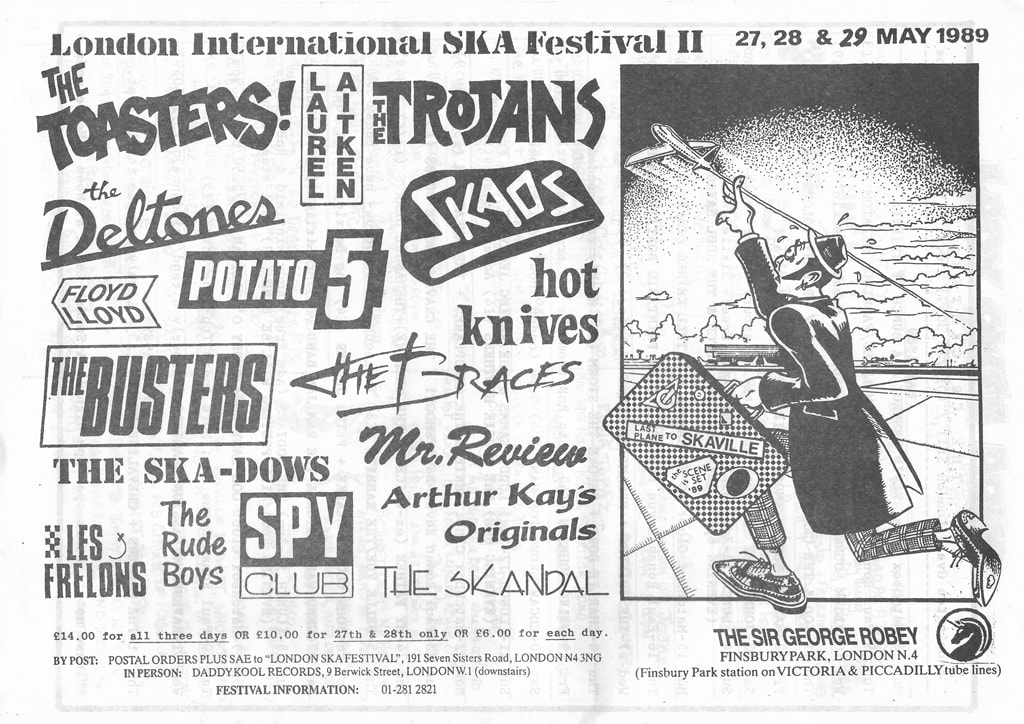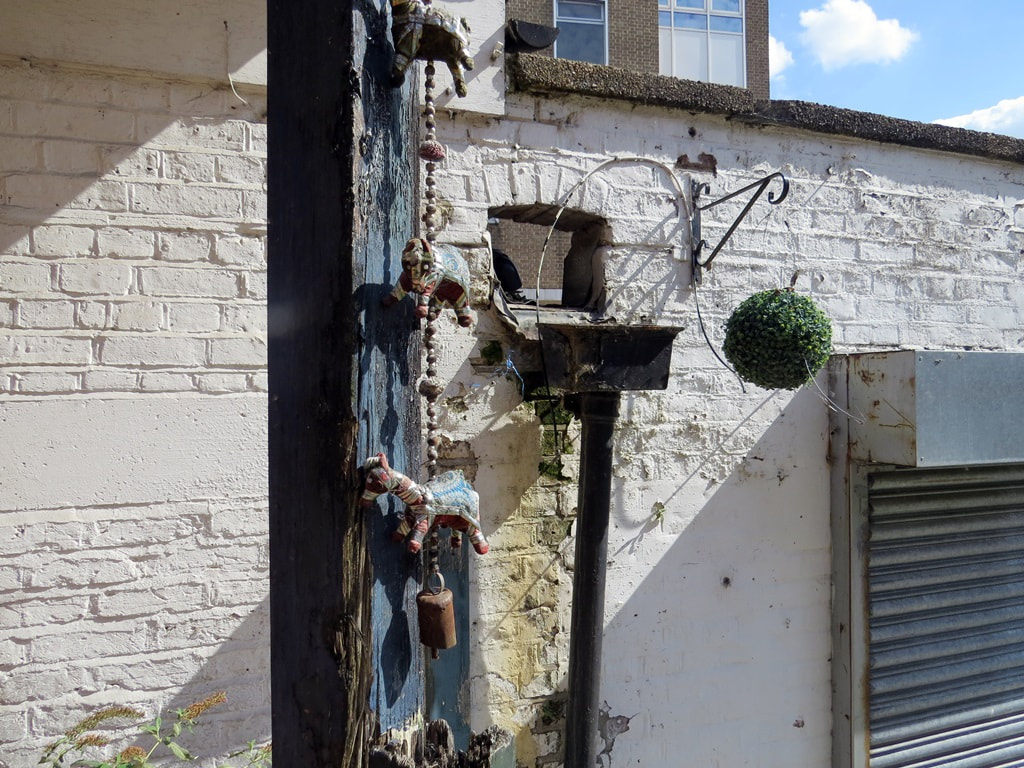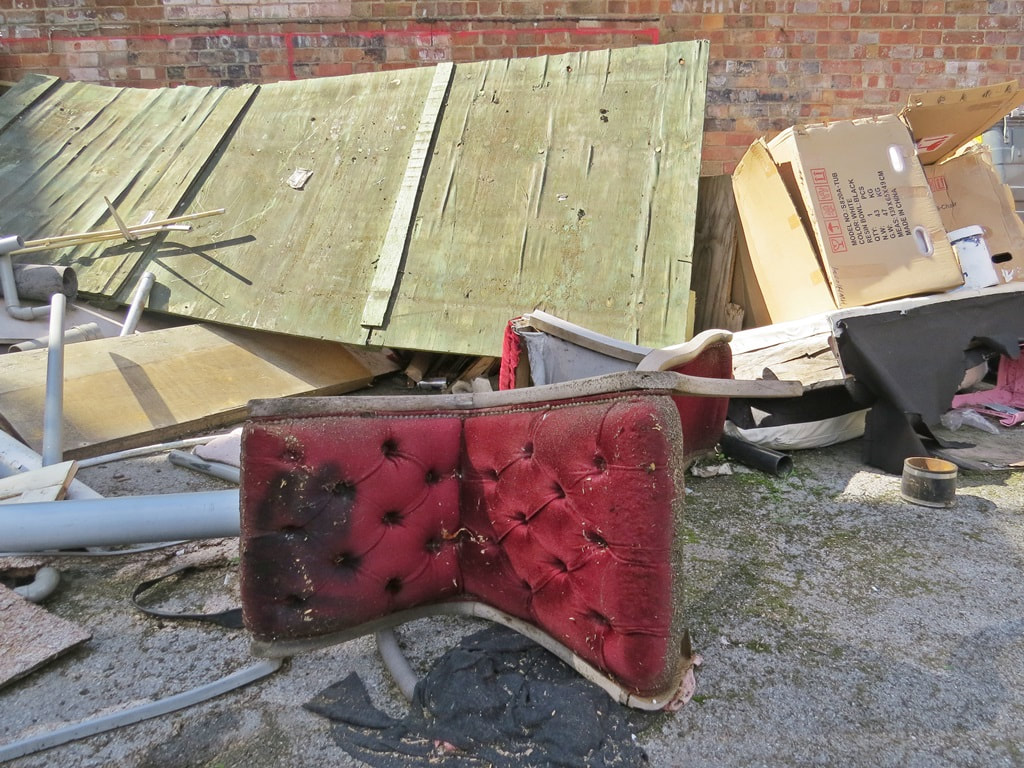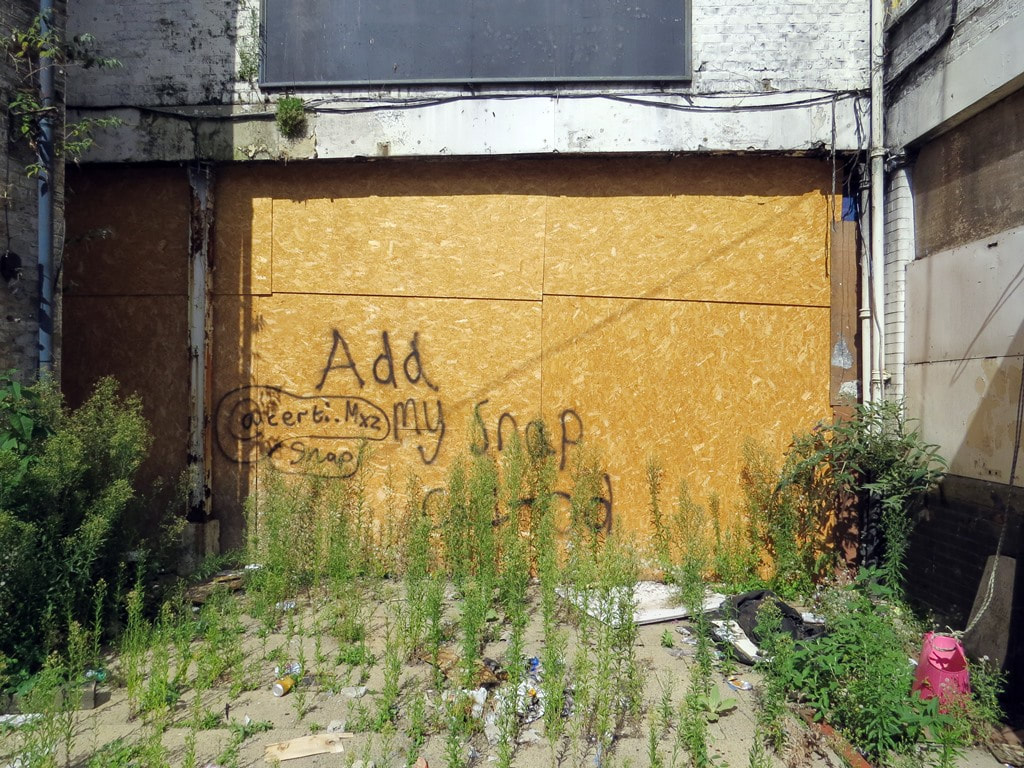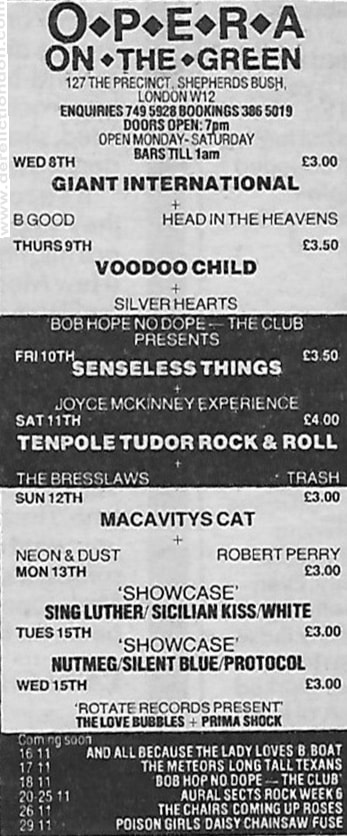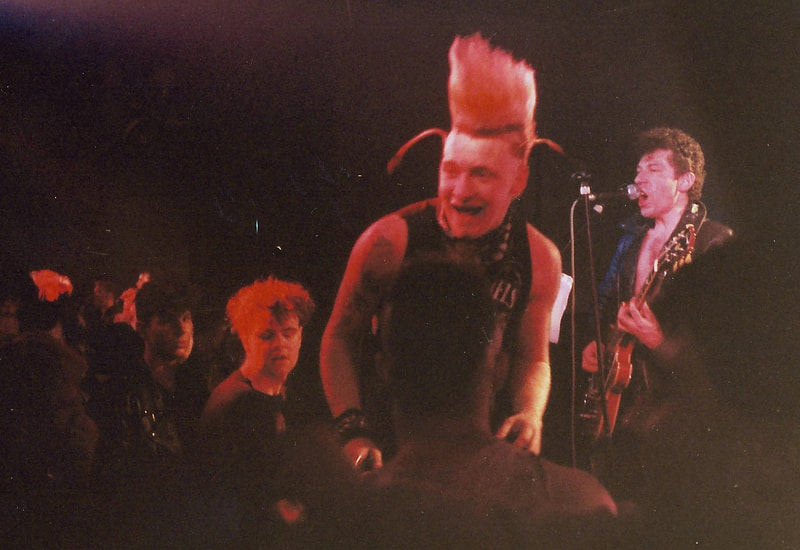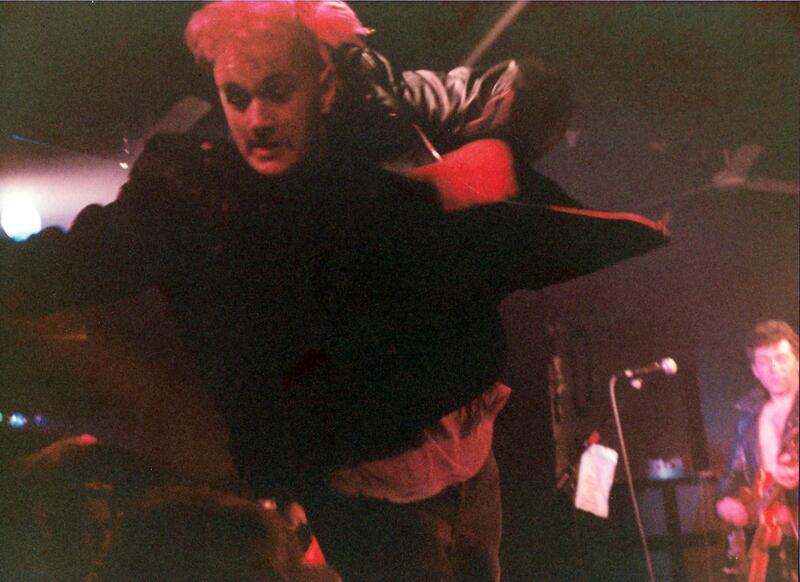Sponsored Links:
Derelict London - London's Lost Music Venues
A section that isn't entirely about dereliction but of places whose "musical heritage" is largely unknown by people who pass by the sites of these buildings. The pictures are the buildings as they are now (unless otherwise stated) plus a few odd scans of pictures that I took of gigs at these venues though we didn't all carry cameras around like we do in this digital age.
Much of the inspiration for creating this part of the website was of seeing all my old haunts of the 80s & 90s turn into flats, etc. The whole project has been made into two books covering venues from post-war to modern day. The first volume concentrating on pubs and clubs was released in 2020 on Damaged Goods Books and volume 2 was released in 2022. For more details, take a look at www.londonslostmusicvenues.com. I offer some guided walks around these sites, so you may wish to join the mailing list to be notified of the dates as soon as they are announced.
Much of the inspiration for creating this part of the website was of seeing all my old haunts of the 80s & 90s turn into flats, etc. The whole project has been made into two books covering venues from post-war to modern day. The first volume concentrating on pubs and clubs was released in 2020 on Damaged Goods Books and volume 2 was released in 2022. For more details, take a look at www.londonslostmusicvenues.com. I offer some guided walks around these sites, so you may wish to join the mailing list to be notified of the dates as soon as they are announced.
The Royal Standard - Blackhorse Lane, Walthamstow, E17
The Royal Standard hosted a few local bands from the early 1960s as well as comedy. Jimmy Jones made his professional debut here. At that time, Jimmy’s stage name was Albert Simmonds but the compère, Don Harvey kept getting his name wrong, Don Harvey told him that he was going to change his name from Albert Simmonds to Jimmy Jones. Around this time too, the Don Harvey Trio played regularly here. They were known at the time for regular appearances on Stars and Garters, a British television variety show set in a fictitious pub.
The 1980s saw the pub split into two and the live room renamed as The Standard Music Venue with rock acts such as Girlschool & Phil Lynott, skinhead faves Condemned 84 & The Business and more indie/alternative acts such as The Cardiacs & The Darling Buds. In the 1980s the pub was also well known on the comedy circuit and hosted Alan Davies, Hale and Pace, Harry Enfield and Jack Dee. Suzi Quatro played in early 1990 followed by nightly line-ups of scores of new hopeful bands such as Ken Dodd’s Dads Dogs Dead who never made it big-time and the occasional lucky ones such as Kula Shaker who went onto have 5 top 10 hits.
As well as up and coming bands, a few older established bands and various tribute acts to AC/DC, Led Zeppelin, David Bowie & Blondie the Royal Standard became increasingly well known on the pub circuit. In 2009, the pub was saved by an off-duty fireman who by sheer coincidence was in one of the bands playing that night when a fire broke out in the flat above.
The pub’s owners closed the Royal Standard music venue late in 2011 and the next door pub (by then called the Tryst). It was bought by a Turkish supermarket chain and the site has been boarded up since and the building is likely to be demolished with provisional planning permission for 50 new flats, a bar, supermarket and a basement music venue.
Below are 5 pics from the final ever evening at The Royal Standard in Blackhorse Lane taken by Simon Stevens 2011). My picture of the entrance was taken in 2012.
The 1980s saw the pub split into two and the live room renamed as The Standard Music Venue with rock acts such as Girlschool & Phil Lynott, skinhead faves Condemned 84 & The Business and more indie/alternative acts such as The Cardiacs & The Darling Buds. In the 1980s the pub was also well known on the comedy circuit and hosted Alan Davies, Hale and Pace, Harry Enfield and Jack Dee. Suzi Quatro played in early 1990 followed by nightly line-ups of scores of new hopeful bands such as Ken Dodd’s Dads Dogs Dead who never made it big-time and the occasional lucky ones such as Kula Shaker who went onto have 5 top 10 hits.
As well as up and coming bands, a few older established bands and various tribute acts to AC/DC, Led Zeppelin, David Bowie & Blondie the Royal Standard became increasingly well known on the pub circuit. In 2009, the pub was saved by an off-duty fireman who by sheer coincidence was in one of the bands playing that night when a fire broke out in the flat above.
The pub’s owners closed the Royal Standard music venue late in 2011 and the next door pub (by then called the Tryst). It was bought by a Turkish supermarket chain and the site has been boarded up since and the building is likely to be demolished with provisional planning permission for 50 new flats, a bar, supermarket and a basement music venue.
Below are 5 pics from the final ever evening at The Royal Standard in Blackhorse Lane taken by Simon Stevens 2011). My picture of the entrance was taken in 2012.
The Sir George Robey - Finsbury Park, N4
(all pictures here are by Paul Talling 1988 -2015)
|
This 1870s pub was originally called The Clarence and renamed the Sir George Robey in the 1960s (named after an old English music-hall comedian). During the late 1980s this place was the venue for any up-and-coming band with a Ford Transit on the ‘toilet circuit’ up and down the country. Folk musician Joe Giltrap ran the Robey in the early 1980s and Christy Moore, The Men They Couldn't Hang, Alien Sex Fiend, T'Pau & The Pogues were some of the acts that he hosted before leaving in 1987. The venue continued largely unchanged into the late 1980s to the mid-1990s and acts included Hawkwind, Steve Marriott, Gong, Blur, No Doubt, Snuff and the Exploited. During this period the Robey was also popular with promoters who hosted all-day punk and SKA gigs In 1989 My old mate Roy & I hosted a punk all-weekender that was so busy that the police had to stop the crowd spilling out into traffic on the Seven Sisters Road. Everybody seemed to have a love/hate relationship with the place, especially the appalling toilets. It certainly attracted great bands, but it was also none too salubrious at times – I remember watching the singer TV Smith slipping over someone’s vomit whilst onstage. The venue also staged all-nighters by Club Dog which had a squat & free party vibe with its psychedelic bands crossing over with the rave scene. Nick Hornby is said to have based the Harry Lauder music venue in the High Fidelity book on the Sir George Robey. The Sir George Robey was taken over by the Mean Fiddler Group in the mid-1990s and renamed the Powerhaus. The venue closed down in 2004 and suffered a fire. Rebuilding started soon after but then abandoned. The building was demolished in Autumn 2015. After the land laying vacant for a few years construction of a Premier Inn hotel was recently completed. In August 2014, I took a look around inside the building, and I was shocked how little of the original interior remained. The only instantly recognisable feature was the entrance where you used to come into the gigs from the front yard. Much of the area had been cleared and replaced with new girders and joists with very unstable boarding over the joists. The main bar area was not boarded over and there was a massive drop into the waterlogged basement/cellar. The area where the stage & cellar below was all demolished and again with a massive drop into an open area overgrown by buddleia with an abandoned mechanical digger overtaken by nature
|
|
And here are some of my pictures taken at the Sir George Robey. All taken in June 1989 at the punk weekender that I hosted (apart from the final pic of the Long Tall Texans who I put on in 1990). Band playing at the punk weekender included: Splodgenessabounds, UK Subs, Culture Shock, The Abs, Guitar Gangsters (1st live gig), The Abs, Red London, The Price (with Paul Fox of The Ruts guesting on guitar), Suspect Device, Red Letter Day and many more.
For more details on the book take a look at www.londonslostmusicvenues.com. I organise some guided walks around many of these sites, so you may wish to request to join the mailing list (click email icon below) to be notified of the dates as soon as they are announced. I also welcome any of your old photographs and flyers/ads for venues which could be used in the second volume of this book and/or this website.
The Bitter End/The Horn/The White Hart - High Street, Romford. RM1
Another lost music venue...
An inn on this site dates back to the 15th Century that was rebuilt during Victorian times and was known as the White Hart Hotel subsequently undergoing many name changes.
In 2006 to 2007 when called The Bitter End acts including Towers of London, Sonic Boom Six, Chas & Dave, Napalm Death, Architects and Mystery Jets played here. In 2010, it was renamed The Horn after the team behind The Horn in St Albans briefly took it over and hosted gigs by Beki Bondage, Captain Sensible, The Glitter Band, Anti Nowhere League, Eastfield and The Duel plus a few nights of tribute bands to the likes of Guns 'n' Roses and Metallica. By 2011 the pub reverted to The Bitter End continuing with many tribute bands plus an array of older well established bands popular in their respected genres such as UK Subs, The Members, The Queers, English Dogs and Discharge for the punks, The Lambrettas for the mods and Condemned 84, The Last Resort and Close Shave for the Oi! Skinheads. Later that year the live music stopped, and the pub closed in 2012.
In 2015, the empty building suffered a fire and in 2017 a group of squatters moved in who spent the next two years as self -appointed caretakers renovating the premises intending for it reopening for community use. Despite much internal restoration having taken place the squatters were evicted in 2019 and the future of the empty building remains uncertain. Below are some pics of the rear of the building.
An inn on this site dates back to the 15th Century that was rebuilt during Victorian times and was known as the White Hart Hotel subsequently undergoing many name changes.
In 2006 to 2007 when called The Bitter End acts including Towers of London, Sonic Boom Six, Chas & Dave, Napalm Death, Architects and Mystery Jets played here. In 2010, it was renamed The Horn after the team behind The Horn in St Albans briefly took it over and hosted gigs by Beki Bondage, Captain Sensible, The Glitter Band, Anti Nowhere League, Eastfield and The Duel plus a few nights of tribute bands to the likes of Guns 'n' Roses and Metallica. By 2011 the pub reverted to The Bitter End continuing with many tribute bands plus an array of older well established bands popular in their respected genres such as UK Subs, The Members, The Queers, English Dogs and Discharge for the punks, The Lambrettas for the mods and Condemned 84, The Last Resort and Close Shave for the Oi! Skinheads. Later that year the live music stopped, and the pub closed in 2012.
In 2015, the empty building suffered a fire and in 2017 a group of squatters moved in who spent the next two years as self -appointed caretakers renovating the premises intending for it reopening for community use. Despite much internal restoration having taken place the squatters were evicted in 2019 and the future of the empty building remains uncertain. Below are some pics of the rear of the building.
Windsor Castle – Harrow Road, W9
The Windsor Castle became part of the early 1970s pub rock scene and became a prolific venue for up and coming bands until the end of 1979.
Members of The 101’ers saw Dr Feelgood play here in 1974, a gig which certainly inspired singer Joe Strummer (who later went on to form The Clash), and The 101’ers would go on to play The Windsor Castle 3 times. The group was named after the nearby squat where they lived together in 101 Walterton Road. The Clash song "Protex Blue" is believed to be inspired by the brand of contraceptives available from the machine in the toilets of the Windsor Castle. The Stranglers mentioned the Windsor Castle in an interview & said that their song "Bitching" was inspired by managers of venues like this that they didn’t like.
Madness played an early gig here to virtually no audience as did the Psychedelic Furs who played a residency in 1979 though they built up a following & by the time of the last gig of the residency the place was packed out. Iron Maiden turned up to play a gig but refused to play early to a near-empty pub leading to an argument with the landlord who subsequently barred them.
Dexys Midnight Runners played their debut London gig here plus early gigs by U2, The Jam, The Ruts, The Cure plus some mod bands such as Merton Parkas, Beggar & The Small Hours.
From 1980 until closure in 2009 the pub continued to host a few live bands though no real rising stars. The pub became more popular locally for karaoke & televised sport & live strippers. New owners applied to demolish the present building & build a 5-storey hotel, but permission was refused. The future of the building remains uncertain, though construction workers have recently been spotted around the site.
Members of The 101’ers saw Dr Feelgood play here in 1974, a gig which certainly inspired singer Joe Strummer (who later went on to form The Clash), and The 101’ers would go on to play The Windsor Castle 3 times. The group was named after the nearby squat where they lived together in 101 Walterton Road. The Clash song "Protex Blue" is believed to be inspired by the brand of contraceptives available from the machine in the toilets of the Windsor Castle. The Stranglers mentioned the Windsor Castle in an interview & said that their song "Bitching" was inspired by managers of venues like this that they didn’t like.
Madness played an early gig here to virtually no audience as did the Psychedelic Furs who played a residency in 1979 though they built up a following & by the time of the last gig of the residency the place was packed out. Iron Maiden turned up to play a gig but refused to play early to a near-empty pub leading to an argument with the landlord who subsequently barred them.
Dexys Midnight Runners played their debut London gig here plus early gigs by U2, The Jam, The Ruts, The Cure plus some mod bands such as Merton Parkas, Beggar & The Small Hours.
From 1980 until closure in 2009 the pub continued to host a few live bands though no real rising stars. The pub became more popular locally for karaoke & televised sport & live strippers. New owners applied to demolish the present building & build a 5-storey hotel, but permission was refused. The future of the building remains uncertain, though construction workers have recently been spotted around the site.
Roger Stanley writes: "We used to live in Elgin Avenue just around the corner from the Windsor Castle W.9, and in 1945/6? Winston Churchill did a big speech to 1000s of us from the verandah. Then we moved to: 50, Wrentham Avenue N.W.10, left there in 1969 to come to OZ. By the way, The Small Faces visited 50 Wrentham Avenue, regularly to study some JAPANESE Chanting stuff, on and on. The lady running the classes was a Japanese lady married to a Mr. Lynch. Not many people know that!"
101 CLUB - St Johns Hill, Battersea, SW11
For a brief few years in the very late 1970s to the early 1980s this small basement club was an important venue on the up and coming band circuit and hosted gigs by U2, A Flock of Seagulls, Big Country, Marillion & Bauhaus.
There was also an in-house record label backed by Polydor which released a series of albums in the early 1980s: “Live at the 101” featuring live recordings at the club. Of the many up and coming acts featured on the compilation albums The Piranhas, The Fixx & Thompson Twins were three of many bands that went on to gain chart success.
In 1982 the 101 club hosted early King Kurt gigs (Rory their drummer worked behind the bar) and a leaving gig for a band member ended in a massive drunken food fight. This started an infamous King Kurt tradition for years to come all around the world whereby the audience brought food to gigs to throw at the band and each other.
After the 101 club closed, there is no record of any live music at the venue. It was used mainly as a late night dance club though reached brief notoriety with national press coverage after undercover journalists exposed the place in News of the World as hosting swingers parties. The club, last known as Rollies, closed down a few years ago and remains empty.
The entrance doorway to the club was between two shops, though on one side the shop has recently been converted into flats. Someone who worked at the old shop tells me that the club in the 1990s had quite a seedy reputation. One morning he found a blood covered knife posted through the letterbox of the shop. The latest photograph (2019) below shows the frontage has had a makeover with wooden panelling.
There was also an in-house record label backed by Polydor which released a series of albums in the early 1980s: “Live at the 101” featuring live recordings at the club. Of the many up and coming acts featured on the compilation albums The Piranhas, The Fixx & Thompson Twins were three of many bands that went on to gain chart success.
In 1982 the 101 club hosted early King Kurt gigs (Rory their drummer worked behind the bar) and a leaving gig for a band member ended in a massive drunken food fight. This started an infamous King Kurt tradition for years to come all around the world whereby the audience brought food to gigs to throw at the band and each other.
After the 101 club closed, there is no record of any live music at the venue. It was used mainly as a late night dance club though reached brief notoriety with national press coverage after undercover journalists exposed the place in News of the World as hosting swingers parties. The club, last known as Rollies, closed down a few years ago and remains empty.
The entrance doorway to the club was between two shops, though on one side the shop has recently been converted into flats. Someone who worked at the old shop tells me that the club in the 1990s had quite a seedy reputation. One morning he found a blood covered knife posted through the letterbox of the shop. The latest photograph (2019) below shows the frontage has had a makeover with wooden panelling.
STOCKWELL, SW9 - THE PLOUGH
The original settlement of Stockwell formed around here in Stockwell Green. The first part of the name derives from "stoc", the Old English word for "wood". Water was drawn from wells on the site and breweries thrived. The building of Inns and taverns naturally followed with The Plough (the original dating back to 1666) and The Swan (circa 1780).
The tiled Truman’s sign with the eagle roundel is that of Truman, Hanbury, Buxton & Company Limited - a London brewer with records stretching back as far as 1666 - the date The Plough opened!
This building was constructed in the 1930s (by Truman's in-house architect AE Sewell) on the site of the original Plough. During the 1960s and 70s the pub was well known all over London as a key jazz pub with live residencies. Musician Phil Seaman used to play here regularly before his death in 1972. Charlie Watts of the Rolling Stones said: “Phil was a one-off player and is probably the best drummer we’ve ever had. There’s a whole crowd of guys who were influenced by him."
It became a hip-hop bar called The Plug in the late 1990s before closing in 2002. Incidentally, the name change was simply because the O and the H fell off the Plough sign, hence The Plug.
Peter writes on the BBC website: "I do miss places like the Plough in Stockwell, where you could see the likes of Keith Tippett, Chris Biscoe, Dudu Pukwana, Nick Evans and John Stevens on a weekly basis in a completely non-pretentious, inexpensive environment. There doesn't seem to be anything like that anymore, more's the pity..."
Savoy Ballroom/The Witchdoctor - Catford, SE6
Before World War II it was the Savoy Ballroom and in 1939 it was commandeered by the government for social services, providing food, drink and medicine to local schoolchildren. In the 1960s it was known as the Savoy Rooms with a gaming club called Mr Smiths on the ground floor with dancing and bands upstairs known as The Witchdoctor from 1965.
Just before the live music club was renamed The Witchdoctor, The Rolling Stones & Gene Vincent played here in 1964. Then bands playing from 1965 onwards at The Witchdoctor included Dave Dee, Dozy, Beaky, Mick and Tich, Jimmy Cliff, The Equals, The Who, The Ethiopians, The Creation, The Skatalites & Desmond Dekker plus smaller popular club circuit bands such as The Loose Ends & The Coloured Raisins. Scottish band The Gaylords played here a few times under both that name and afterwards once they had changed their name to Marmalade.
The owners of Mr Smiths asked South London gangsters Eddie Richardson and Frankie Fraser to protect the club in exchange for gaming machines being placed there. In 1966, a fight broke out in the early hours of the morning and Richard Hart an associate of the Kray twins was shot dead near the bottom of the stairs as he was making his getaway. In revenge Ronnie Kray shot and killed George Cornell, a member of the Richardson Gang, at the Blind Beggar pub in Whitechapel the following evening.
Gigs continued until 1969 and the ground floor was converted to retail and the first floor became a snooker hall though in recent years it has been used as a Pentecostal church and is called the Right Now Jesus Centre.
Just before the live music club was renamed The Witchdoctor, The Rolling Stones & Gene Vincent played here in 1964. Then bands playing from 1965 onwards at The Witchdoctor included Dave Dee, Dozy, Beaky, Mick and Tich, Jimmy Cliff, The Equals, The Who, The Ethiopians, The Creation, The Skatalites & Desmond Dekker plus smaller popular club circuit bands such as The Loose Ends & The Coloured Raisins. Scottish band The Gaylords played here a few times under both that name and afterwards once they had changed their name to Marmalade.
The owners of Mr Smiths asked South London gangsters Eddie Richardson and Frankie Fraser to protect the club in exchange for gaming machines being placed there. In 1966, a fight broke out in the early hours of the morning and Richard Hart an associate of the Kray twins was shot dead near the bottom of the stairs as he was making his getaway. In revenge Ronnie Kray shot and killed George Cornell, a member of the Richardson Gang, at the Blind Beggar pub in Whitechapel the following evening.
Gigs continued until 1969 and the ground floor was converted to retail and the first floor became a snooker hall though in recent years it has been used as a Pentecostal church and is called the Right Now Jesus Centre.
Sample pages from the London's Lost Music Venues Book: The Trafalgar/Opera On The Green - Shepherds Bush, W12
Below are a few of my photographs of gigs that I promoted at Opera on The Green in 1989. Shame that I didn't take my camera to the Manic Street Preachers gig. I had a signed contract by the band promising to pay them £30 for playing the gig, but I can no longer find it. After the gig the Manics wouldn't accept the full fee and only accepted £20!
For more details on the books, take a look at www.londonslostmusicvenues.com. I shall be organising some guided walks around these sites, so you may wish to request to join the mailing list (click email icon below) to be notified of the dates as soon as they are announced. I also welcome any of your old photographs and flyers/ads for venues which could be used in updated editions of the books and/or this website.
Paul Talling's Derelict London - all photographs are copyright © 2003-2024
Click the envelope icon to join the mailing list for occasional news on website updates, new book releases and Paul's guided walking tours. Follow Derelict London on Facebook and Twitter
Please do not contact me with property/ filming/photo shoot location queries
Click the envelope icon to join the mailing list for occasional news on website updates, new book releases and Paul's guided walking tours. Follow Derelict London on Facebook and Twitter
Please do not contact me with property/ filming/photo shoot location queries






